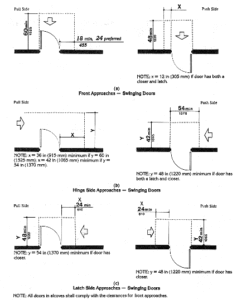For IMMEDIATE service, storm damage & other emergencies, please call our
24HR Service Hotline at (847) 877-5580

24HR Service Hotline at (847) 877-5580
 DSI is a full service provider of installation and products that meet or exceed the ADA Guidlines.
DSI is a full service provider of installation and products that meet or exceed the ADA Guidlines.
Americans with Disabilities Act
“No qualified individual with a disability shall, on the basis of disability, be excluded from participation in or be denied the benefits of the services, programs or activities of a public entity, or be subjected to discrimination by any public entity.”
28 CFR 35.130
QuickTime Format (Requires QuickTime Player)
RealPlayer Format (Requires RealPlayer)
At its core, the Americans with Disabilities Act is about access. The act, signed into federal law in 1990, requires stores, banks and other businesses with public buildings to guarantee service to people with disabilities. Part of the act details how building owners can upgrade entryways to provide access for the disabled. However, not all buildings need retrofits to comply with the law. A building’s construction date determines whether an upgrade is needed.
ADA-compliant doors must be wide enough to accommodate wheelchairs. The law calls for entryways to be at least 32 inches wide, as measured between the door’s face and the opposite doorstop when the door is open 90 degrees. Clearance around doors must be 36 inches. The law exempts doors that don’t require full passage to access a room, such as an entryway into a closet less than 2 feet deep. The minimum width on such doors is 20 inches.
For double doors, the minimum width is 48 inches, and the doors must swing in the same direction. The floor or ground around the door must be level and clear of obstructions. In addition, doorway thresholds can’t be higher than 3/4 inch for exterior sliding doors, and no higher than half an inch for all other door types. If a door is at the end of a hallway, wheelchair access requires a clearance around the door of 54 inches.
Federal law also governs handles, pulls, latches and locks, as well as a door’s opening force and closing speed. Hardware must have a shape designed for easy grasping with one hand, and can’t require tight pinching or wrist-twisting to operate. Hardware required for opening can’t be mounted more than 48 inches above the floor. A door with a closer must take at least three seconds to shut to within 3 inches of the latch. The maximum allowed force necessary to open a door is 5 pounds. The exception is a fire door, which must have the minimum force allowed under local zoning codes. Automatic-door units must be low-energy models, must take at least three seconds to open and can’t require more than 15 pounds of force to stop door movement.
The ADA also regulates access to a building’s doors. A building that has just one entrance up a flight of stairs, with no wheelchair ramp, violates the law. Exterior entryways must also connect via a wheelchair-accessible route to public transportation stops, to accessible parking and passenger-loading areas, and to public streets and sidewalks. The law also mandates that exterior doors link to all wheelchair-accessible areas inside the building. A service entrance can’t be the only accessible entrance into a building, unless it’s the building’s only entryway — for example, into a garage.
Not every building needs upgrades to comply with the ADA. The law’s accessibility rules went into effect Jan. 26, 1992, and property owners don’t have to retrofit doors on buildings built before that date. For example, operators of a museum built before the effective date could move inaccessible exhibits to a reachable area or offer a video of the exhibits, rather than install new doors.
The ADA requires only that owners of public accommodations such as shopping centers, hotels and restaurants remove access barriers in existing buildings when doing so doesn’t require significant difficulty or expense. Businesses can also wait to make modifications until they have the financial means to afford the upgrades and the federal government offers tax credits for retrofits. However, all buildings constructed or modified after the effective date must comply with the law.